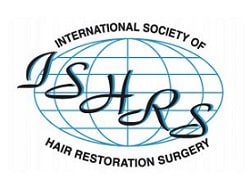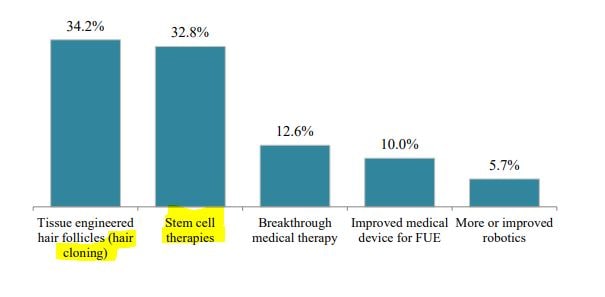ISHRS 2020 Hair Transplant Statistics
 Recently, the International Society of Hair Restoration Surgery (ISHRS) published its 2020 census results. There are some very interesting hair transplant related findings presented in there.
Recently, the International Society of Hair Restoration Surgery (ISHRS) published its 2020 census results. There are some very interesting hair transplant related findings presented in there.
However, the most interesting findings to me are those unrelated to hair transplants.
The previous ISHRS census came out in 2017.
How Many Hair Transplants Each Year?
Only 270 hair transplant surgeon members responded in time to the survey request. After extrapolation and adjusting for anomalies, the ISHRS estimated that 735,000 hair restorations procedures were performed worldwide in 2019. This number represents a 16 percent increase from the last estimated total for calendar year 2016.
Whenever I have seen such survey results in the past, I have always been highly skeptical about the annual hair transplant totals. Although the ISHRS has around 1000 members across 70 countries, there are likely several thousand surgeons in developing countries who do not join this organization.
Many of these “missing” surgeons likely offer hair transplants as a side offering at their general cosmetic surgery and dermatological practice. And many hospitals likely have surgeons who perform hair transplants infrequently during emergencies such as burning accidents.
This under-representation is even more exaggerated when you consider the numerous sketchy “roadside” hair restoration clinics in many developing countries. Most of these assembly line type clinics would likely not even get ISHRS membership applications approved.
Moreover, many legitimate clinics and surgeons in poorer countries cannot afford to join the ISHRS and pay annual dues. And many probably do not deem it worth joining a US headquartered organization. Especially if most of their local clients do not care about certifications and international association memberships.
I would therefore not be surprised if the actual number of hair transplant procedures that take place worldwide is closer to 2 million or even higher. The ISHRS totals for vastly populated China and India are likely heavily underestimated. The cost of a hair transplant in these countries is a small fraction of that in the developed world.
I think that there is also significant underestimation when it comes to places such as Turkey, UAE (Dubai) and Thailand. In fact, a number of online news articles from reputable sites suggest that 100,000 hair restoration procedures take place in Turkey alone every year.
However, before booking a flight, make sure to read my post on the dangers of getting a hair transplant abroad.
Other Hair Transplant Statistics
Among the other interesting hair transplant statistics and related findings in this census/survey include:
- An 85 percent to 15 percent split in the male versus female share of the hair transplant clientele. Not surprising.
- A 66 percent “FUE only” versus 30 percent “FUT (strip) only” procedure type performed division. Also not surprising to me. See my past post on FUE versus FUT. The vast majority of FUE procedures are performed by motorized techniques, usually without suction.
- Robotic-assisted FUE represents only 5.3 percent of all FUE procedures performed in the world.
- 99 percent of FUE surgeons used punches of less than 1 mm size. No-one used punches of less than 0.8 mm size.
- When it comes to FUE donor sites: 92.5 percent included scalp hair; 7.5 percent included beard hair; and 2.4 percent included chest hair. Body hair transplants (BHT) are therefore still not very popular.
- 57 percent of patients needed only 1 procedure to achieve their desired result. A bit surprising to me. However, my guess is that many of these satisfied customer will eventually come back for a second procedure after some years due to further hair loss.
- 81 percent of patients have between 1000-3000 grafts transplanted during their first procedure.
- 87 percent of patients were between the ages of 26 and 45.
- Only 13.4 percent of hair transplant surgeons’ patients came from a different country.
Present Hair Loss Treatment Survey
To me, the most interesting parts of this census were not related to hair transplant statistics!
First, on page 16, there is a table titled: “How Often Various Treatments Were Prescribed to Patients in 2019“. 204 surgeons responded to this question. Not surprisingly, Finasteride and Minoxidil were by far the most popular treatment recommendations.
These two are the only ever FDA approved medications to treat androgenetic alopecia (aka male pattern baldness). The Finasteride recommendation breakouts in the table were split into 1% and 5% doses; as well as a separate topical Finasteride category.
I was surprised by the following findings:
- A higher than expected 10.2 percent of responding physicians stated that they “always or often” prescribed oral Minoxidil to treat hair loss. In my past post on oral Minoxidil, I mentioned how it was become increasingly popular in Australia and Thailand. I would be nervous about the side effects of taking such a medication to treat high blood pressure. Especially a potential increase in body hair. However, it seems like many hair loss sufferers are biting the bullet and hoping to get superior results to topical Minoxidil.
- Only 5.9 percent of the doctors “always or often” prescribed Dutasteride to treat hair loss. Very low in my opinion. Almost all comparison studies show that Dutasteride is superior to Finasteride in treating hair loss. But the former also has greater rates of side effects. It seems like hair transplant surgeons are reluctant to prescribe Dutasteride off-label to treat pattern hair loss. Even natural DHT blocker Saw Palmetto was recommended as a hair loss treatment more frequently (8.5 percent) than Dutasteride.
- Around 30 percent of patients were often recommended to take natural supplements, vitamins, herbs and Biotin. Nutritional deficiency related hair loss is not common, and is usually temporary in nature. So this number is higher than I would expect.
Future Treatments
My favorite question is on page 25: “What do you think will be the next technological “leap” in hair restoration?”
201 surgeons answered this question, with hair cloning and stem cell therapies being the most popular responses:

The post ISHRS 2020 Hair Transplant Statistics appeared first on Hair Loss Cure 2020.

